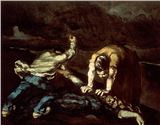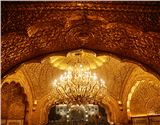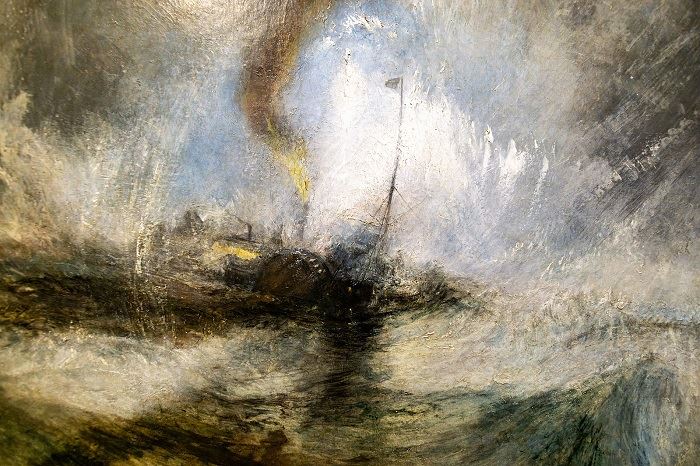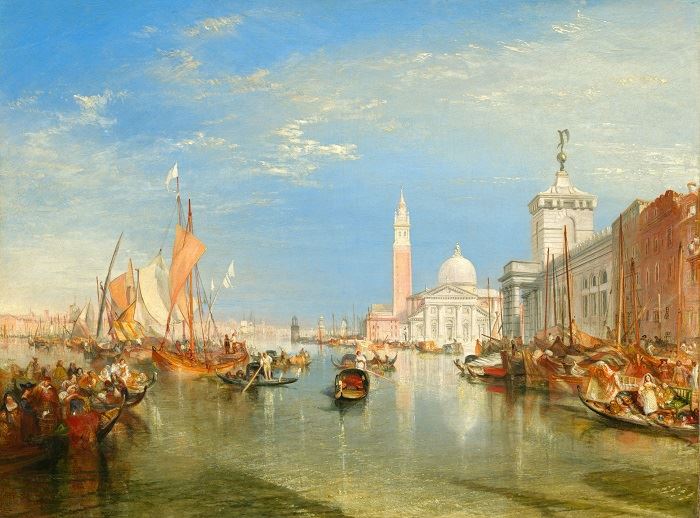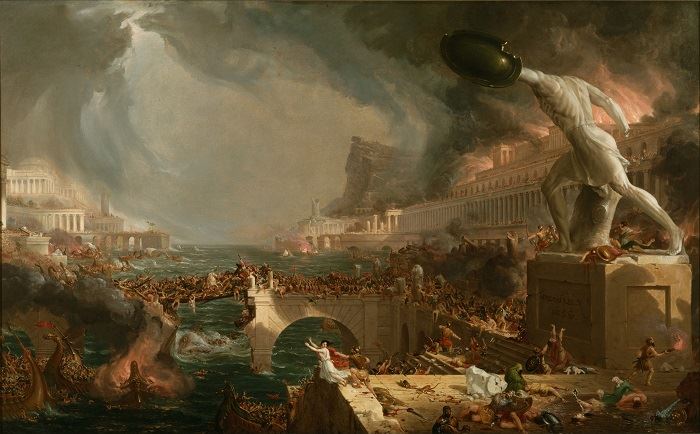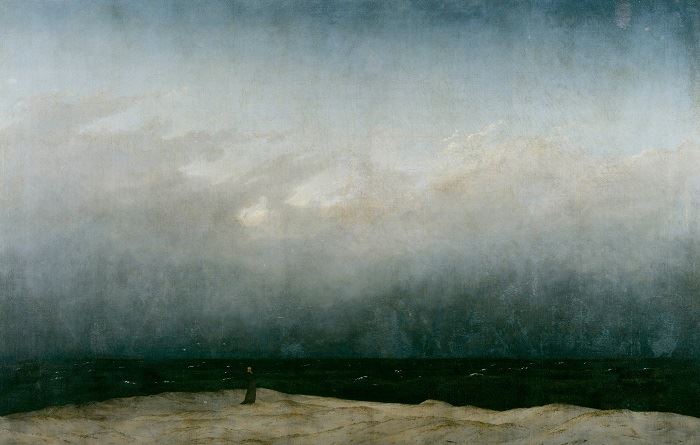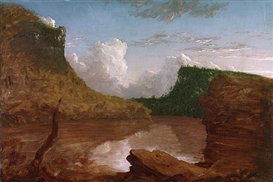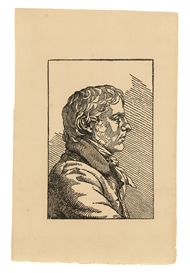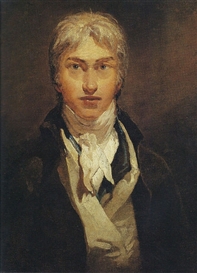The Heart of Silence: Romanticism and the Sea
Romantic artists did not believe in man’s “triumph over nature.” Instead, they advocated for peaceful coexistence with forces much larger than human beings
Abigail Leali / MutualArt
Feb 10, 2023
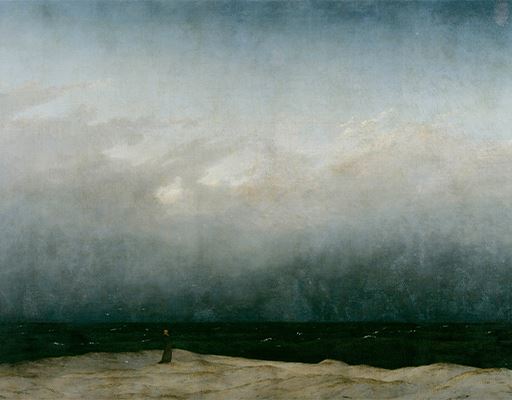
We don’t think about it much today, but if there is anything in the world upon which we are most dependent, it is not market forces, political maneuverings, or supply chains. It is still almost certainly water. A human being can survive for weeks without food — and almost indefinitely with only the least bit of shelter — but only a handful of days without water. Just as the ancients prayed for rain to nourish their crops and used rivers to facilitate travel and trade as civilizations expanded, so we today rely on networks of irrigation and shipping to keep our globalized civilization afloat. But water is a notoriously capricious resource. As much time, money, and effort as we may expend in containing it, it will never fully bend to our will.
All of this may ring a bit empty to our modern ears. The luxuries of water sanitation plants, indoor plumbing, air travel, and satellite imagery, have made it easy for many of us to distance ourselves from our reliance on water and from its raw power – even as we continue to acknowledge these as obvious facts. And yet, imagine for a moment what it must have been like to live in a world without any of these amenities: a world in which looking out from the shore or sailing around the coast was as far as you could ever hope to go. The sea would seem to tower over you as an endless wall as it approached the unreachable horizon. It would feel insurmountable, unfathomable, unpredictable, impassible. It might even feel like encountering God.
J.M.W. Turner, Steam-Boat off a Harbour's Mouth, 1842
While it may be easy for us, therefore, to dismiss the wooden warships and steamboats of centuries past as child’s play compared to our modern hangars and submarines, there is a reason these massive craft were so celebrated in their time. They marked a distinct shift in humanity’s relationship with water, one that rivaled that of the airplane itself. As seafaring grew safer, easier, and more profitable, so too did man’s confidence in his victory over nature.
In early Anglo-Saxon poems like The Seafarer, the ocean is metaphorically conflated with the divine, and seafaring with a life of penance, in which one submits oneself to hardships to more fully encounter what it means to be alive – “all [the things of the world],” it says, “admonish the willing soul / the spirit to travel … far on the sea.” By the time of the Titanic, however, society had grown so complacent in its dominance over the waters as to fancy its ships “unsinkable.” For better or worse, to sail was no longer to have a relationship with water; instead, it was to assert one’s will in the face of it.
Romantic artists of the early- and mid-nineteenth century, such as J. M. W. Turner and Thomas Cole, famously looked askance at their peers’ brash insistence on the supremacy of the human will. They recognized that our dependence on nature had not waned; only our opportunities for direct encounter with it had. Romanticism was a movement obsessed with the natural world: with trees and hills and mountains and seas. But it was not merely for the sake of these things themselves; rather, the Romantic artists were entranced by the transcendent power that nature still held, even in the face of all of society’s advances. In many instances, this power was typified by the sea.
Take, for example, Turner. Most of his paintings are of stormy seas, including Steam-Boat off a Harbour’s Mouth. In this piece, the paint strokes themselves are visceral, cracked, and choppy, almost obscuring the form of the ship in their wild frenzy. The boat attempts to light a signal, but it is consumed by the enfolding clouds. This is the sea at its most terrible – but it is impossible to look away. Through the lens of his contemporary society, Turner taps into a deep well of instinctual human awe at the wild force of the ocean, a sensation torn at once between fear and exhilaration.
J.M.W. Turner, Venice - The Dogana and San Giorgio Maggiore, 1834
That is not to say that he was too haughty to appreciate the joy and prosperity brought about by technological advances. On the contrary, in other of his works, he seems not only to tolerate but to truly love the care and craftsmanship that has gone into Venetian society. In Dogana and San Giorgio Maggiore, for instance, the placid waters and clear skies mirror the bright white facades of the architecture, and people crowd into boats on the shallow waters to fish, drink, and enjoy each other’s company. This is a hopeful Venice, one that has made its peace with the water and can find joy in it.
And yet, compare this scene to Thomas Cole’s Course of Empire. The scene of Cole’s Consummation is similar to Turner’s Dogana: glittering white marble buildings, flowing fabrics, and crowds of people dotting the coast in celebration as ships glide in from a serene sea. But as Consummation gives way to Destruction, Cole’s waters grow choppy, and the sky mounts above the scene in a threatening arch, as if God himself were breathing down wrath upon the world. Key to the Romantic understanding of the world is this kind of shocking instability. As much as one may love one’s home, as hard as one may try to protect and nourish it – as hard, even, as one may work to cooperate with nature – there will always be forces at play beyond anyone’s control. In this way, to be a Romantic is thus to be an anti-humanist – to acknowledge the smallness of human agency in the face of an overwhelming world.
Thomas Cole, Destruction, from the Course of Empire series, 1836
The Romantics’ fascination with nature, however, was not always as morbid as these examples may make it appear; the goal of the exercise was not so much to abase man as to remind him of the heights to which he could yet ascend. Caspar David Friedrich’s Monk by the Sea is perhaps the perfect type of this phenomenon. The composition is utterly overwhelmed by the sea and the sky; the monk himself stands like an isolated pillar, his habit blending so perfectly with the dark, stormy waters as to render him one with the water. He stands at the bottom of the frame, all but subsumed into the world around him. At first, it may seem as if he is insignificant – and, compared to the grand portraits adorning royal palaces, he may indeed be so. Yet this painting serves as a visual metaphor for contemplative prayer – for the sensation, as T. S. Eliot puts it in The Burial of the Dead, of “looking into the heart of light, the silence.” In allowing himself to become a mere part of the scene, this monk has found a place in the greater picture.
Caspar David Friedrich, The Monk by the Sea, c. 1808-1810
This is the core of the Romantic’s vision of the sea. It was a place whose very existence was a poem and a treatise, always reminding man that, no matter how high or far he could travel or how often he tried to escape, he would always and forever be a contingent being. The world outside of him would always and forever be infinitely bigger, more beautiful, and more complex than him, and he would always rely on it for even his most basic needs. But this was not a reality to be feared or ignored; in fact, the Romantics instinctively sought out this sensation of smallness and oneness with the world. They saw in this path of littleness a way to approach the fullness of being itself. Many went so far as to deem it an immanent manifestation of God.
It was people such as these whom Melville must have had in mind when he invented the character of Ishmael for Moby-Dick. “Whenever I find myself growing grim about the mouth,” Ishmael famously observes,
whenever it is a damp, drizzly November in my soul; whenever I find myself involuntarily pausing before coffin warehouses, and bringing up the rear of every funeral I meet … then, I account it high time to get to sea as soon as I can. This is my substitute for pistol and ball. With a philosophical flourish Cato throws himself upon his sword; I quietly take to the ship. There is nothing surprising in this. If they but knew it, almost all men in their degree, some time or other, cherish very nearly the same feelings towards the ocean with me.
Melville’s vivid imagery deserves to be treated as a work of art in its own right. Like Turner and Friedrich and Cole, he recognizes that there is something about the ocean that reflects us to ourselves, particularly in those increasingly brief moments when the veneer of technological comfort fails and we must come face-to-face with our temporality and dependence. Like Ishmael, it only remains for us to embrace it.
For the Romantics – as for their Anglo-Saxon ancestors – the ocean was a place where they could face, quite literally, their mortality. It was a place where the problem of evil was on full display, and, like Jacob wrestling with the angel, they could grapple with it through the stormy night until daybreak. And ultimately, as with Friedrich’s monk or Melville’s Ishmael, it was a place where they could refresh their souls amid the bustle and smog of contemporary life and, rather than try to conform these things to their own liking, learn to find peace and joy in being exactly where they were.
For more on auctions, exhibitions, and current trends, visit our Magazine Page


